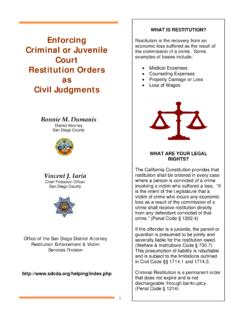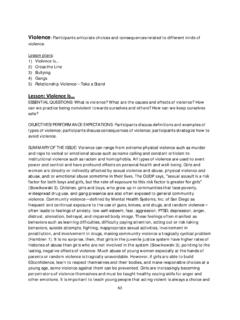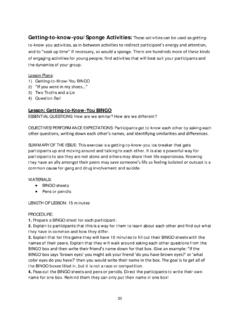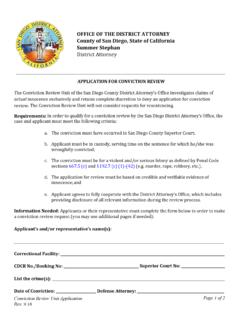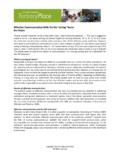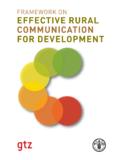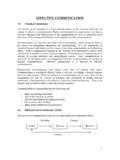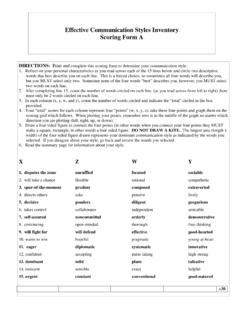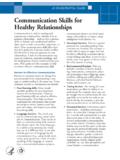Transcription of Communication: Participants practice effective ...
1 53 communication : Participants practice effective communication skills . Lesson plans: 1) Ways to Communicate 2) Conflict Resolution 3) Online communication : Internet safety 4) Human knot 5) Forgiveness Lesson: Ways to Communicate ESSENTIAL QUESTION: What are some ways humans communicate? OBJECTIVES/PERFORMANCE EXPECTATIONS: Participants learn about different forms of communication ; Participants practice different forms of communication . SUMMARY OF THE ISSUE: communication is what we do to give and get understanding; it is the process of sending and receiving messages. Successful communication occurs when there is understanding. communication can be verbal, using oral language to convey a message, or non-verbal, including facial expressions, body language, text or written based language. Sometimes a message s original meaning gets lost in the translation between thought and the act of communicating it.
2 Teaching young people how to communicate effectively helps them maintain healthy relationships, resolve conflicts peacefully, excel in school, and eventually get and keep jobs. MATERIALS: Paper Pens and pencils LENGTH OF LESSON: 30 minutes PROCEDURE: 1. Begin by playing the game Telephone. Have Participants sit in a circle. Ask one participant to think of a phrase or sentence. Direct them to whisper it in the ear of the person sitting next to them. Each participant whispers what they think they heard to the next participant next to them. The last participant says the phrase or sentence out loud. Ask the first participant if that was their phrase. Did anything change? Did the message get lost or changed in translation? This is an example of verbal communication . 2. Now play the game Charades. Have Participants get up one at a time to act out a phrase or sentence without using any words or sounds while the others guess the phrase or sentence.
3 Ask Participants to explain what they did to communicate their message when they were unable to use words (ex: facial expressions, body language, gestures). Were others able to guess the 54 phrase or sentence? Was the message delivered effectively? This is an example of non-verbal communication . Explain that we all communicate all day long, whether or not we are using words. Explain that others pick up messages from our facial expressions, body language, gestures, and general demeanor. 3. Have partners get in pairs. Direct them to communicate hello to their partner three different ways. If they need help, remind them that they can use verbal words, written text, their body or a gesture, or even do something creative. 4. Next have them communicate a feeling to their partner. Give examples of feelings: sad, angry, happy, excited, jealous, confused, or worried. The other partner will guess what feeling they are portraying.
4 For example if their feeling was sad they could say or write I feel sad , make a facial expression, or show with their body how they feel) 5. Give examples from telephone and charades to demonstrate that what you want to communicate is not always what others understand. Explain this is how rumors and gossip spread: someone tells someone a secret and it gets passed on and it gets changed and distorted along the way, just as the message did in telephone. 6. Remind Participants that being clear and concise in their verbal and non-verbal communication is an important life skill that needs to be practiced. 7. Finish by using non-verbal communication to ask Participants to take out their journals or that you ll see them later or that you love them! Have Participants guess your message and then do the action. JOURNAL PROMPT: How do you communicate most often? How would you get people to understand you if you couldn t communicate that way anymore?
5 EVALUATION: Did Participants practice communicating in multiple ways? RELATED ACTIVITIES: Have Participants tell a story about themselves without using words. Or using only words! Lesson: Conflict Resolution ESSENTIAL QUESTION: How can conflicts be resolved peacefully? OBJECTIVES/PERFORMANCE EXPECTATIONS: Participants use scenarios and role playing to learn ways to resolve conflicts peacefully; Participants examine choices and consequences involved in settling disagreements or tension. SUMMARY OF THE ISSUE: Conflict resolution means working out a problem or disagreement without fighting, running away or going against your feelings. Knowing how to handle conflicts in a positive way can help people stay safe from violence, feel good about themselves, and learn to respect others. Physical violence, name-calling, threats, bullying, teasing, and other forms of negative communication often escalate conflicts and leads to serious consequences, including physical injury, lowered self-esteem, and punishment.
6 Good communication involves being a good listener, considering and respecting the other person s point of view, working 55 together to think of solutions, and learning to relax the body and calm the mind during high-tension situations. Practicing these positive communication skills can help people make responsible choices during high-tension situations and avoid violence and further problems. MATERIALS: Role playing scenarios Large paper or board to write feelings and ideas LENGTH OF LESSON: 30 to 45 minutes PROCEDURE: 1. Begin by asking the Participants to raise their hands if they ve ever been involved in a conflict (ex: a disagreement or a fight with someone). Brainstorm what might cause a conflict (ex: bullying, teasing, gossip, jealousy, prejudice, broken friendships, broken romances, possessions, different points of view, wanting a different outcome to a problem). 2. Ask them to brainstorm some feelings that might go along with being in a conflict (ex: angry, jealous, lonely, scared, confused, disappointed, worried, sad).
7 Write these feelings on the board or large paper as the students say them. 3. Explain that when we are involved in a disagreement or any conflict, there are choices we can make; every choice we make has a consequence. Explain that learning about conflict resolution, or learning about how to work things out peacefully without fighting, running away, or going against your own beliefs, can keep your safe from violence, make you feel good about yourself, and help you learn to respect others. 4. Explain the role playing activity. For every scenario, watch the set-up scene, have a volunteer come and help resolve the conflict, and then brainstorm ideas together about what choices can be made and what the consequences are of those choices. Demonstrate a scenario and the conflict resolution. Ask if there are any questions. 5. Ask for volunteers or choose Participants to be the actors. 6. Read the scenario and then have Participants act out the scenario (see sample scenarios below, or come up with your own).
8 Have someone come in to help resolve the conflict. Step in as needed to give suggestions. Have the Participants actually say the words of the peaceful conflict resolution to practice . 7. Have the group identify the problem, the feelings that may be involved, and then have the group come up with a list of choices and their corresponding consequences. Ask: What choices can be made to escalate this incident or make it worse? What choices can be made to resolve this conflict peacefully or make it better? What choices could have been made to avoid this incident altogether? When is it helpful to ask someone (a teacher, a friend, a parent, a trusted adult) to mediate/step in and help solve a conflict? 8. Finish by asking the Participants if they have an example of a positive conflict resolution situation they were part of and would like to share. Scenarios with scripting: 56 Scenario #1: I was sitting here first (problem: stealing) Sarah was sitting in a chair.
9 She got up to use the bathroom. When she came back, Dana was sitting in that seat. The person who was sitting there first wants their seat back and the other person doesn t want to give the seat up. (Choices: hit each other and get into a fight someone gets hurt, they both get in trouble, no one gets the chair. OR Discuss and explain calmly, both people compromise, get another chair everyone has a chair, no one gets hurt OR Ask a teacher for help the teacher assists them discussing and explaining calmly, everyone gets a chair, no one gets hurt.) Scenario #2: That s mine (problem: stealing) Jolie and Carrie are sitting next to each other eating a snack. When Jolie turns to talk to another friend, Carrie grabs Jolie s snack and hides it in her lap. Jolie turns back and notices her snack is gone and suspects that Carrie stole it. (Choices: call names, yell to give back the snack, threaten to slap her if she doesn t give it back, grab the snack back out of her lap someone gets hurt, both get in trouble, they stay mad at each other OR discuss and explain calmly or get a teacher, Jolie gives the snack back and apologizes, Carrie accepts the apology they both get to eat the snack, no one gets hurt or in trouble, they stay friends) Scenario #3: I heard you said you didn t like me (problem: gossiping, teasing, bullying) Amina overhears a group of girls making fun of the outfit she is wearing today.
10 She notices that Lauren, a girl who has teased her about her clothes before, is part of that group. Amina feels like crying. (Choices: go yell at the group, punch Lauren, run away and hope it doesn t happen again someone gets hurt, everyone gets in trouble, Lauren continues to tease and bully Amina, Amina continues to feel sad OR Amina walk up to the group and tells them how their comments make her feel Lauren and the group apologize, Lauren and the group continue to tease Amina OR Amina gets a teacher to help her confront the group) Scenario #4: I thought we were friends (problem: ditching, silent treatment, leaving out) Camille and Stephanie are good friends. They have sleepovers and hang out together at recess every day. Over the summer Camille s cousin Breanne from Los Angeles moved into Camille s family s home. Since the school year started, Camille and her cousin have been hanging out at recess together every day and Stephanie has not been invited to any sleepovers.
